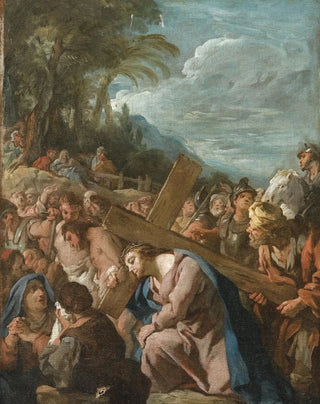Art print | The Carrying of the Cross - Jean-François de Troy


View from behind

Frame (optional)
Reproduction of The Carrying of the Cross - Jean-François de Troy – Captivating Introduction
In the vibrant universe of baroque art, "The Carrying of the Cross" by Jean-François de Troy stands out for its emotional intensity and masterful composition. This artwork, which depicts the poignant moment of Christ's Passion, transcends mere religious representations to offer a profound reflection on human suffering and redemption. The scene, filled with drama, captures the instant when Christ, burdened by the weight of his cross, is surrounded by figures expressing both compassion and despair. Through this art print, viewers are invited to immerse themselves in an atmosphere charged with spirituality and pathos, where every detail contributes to the expression of a universal message.
Style and uniqueness of the work
Jean-François de Troy's style is characterized by an impressive mastery of light and shadow, a fundamental element that gives his works unparalleled depth. In "The Carrying of the Cross," the play of light highlights the faces of the characters, emphasizing their emotions and creating a striking dynamic. The colors, both rich and nuanced, contribute to the scene's intensity, while the carefully orchestrated gestures of the figures guide the viewer's gaze through the composition. This painting does not merely depict a historical moment; it manages to express the inner struggle of each character, making the scene all the more poignant. This ability to combine technique and emotion makes this work a remarkable example of French baroque.
The artist and his influence
Jean-François de Troy, born in 1679, established himself as one of the major figures of French art in the 18th century. His artistic journey was marked by solid training with the great masters of his time, but also by a personal sensitivity that led him to explore various themes, from religious scenes to portraits. De Troy was influenced by the baroque movement, but he also integrated elements of classicism, creating a unique style that is his own. His work had a lasting impact on his contemporaries and paved the way for many artists who followed in his footsteps. By revisiting traditional themes

Matte finish

View from behind

Frame (optional)
Reproduction of The Carrying of the Cross - Jean-François de Troy – Captivating Introduction
In the vibrant universe of baroque art, "The Carrying of the Cross" by Jean-François de Troy stands out for its emotional intensity and masterful composition. This artwork, which depicts the poignant moment of Christ's Passion, transcends mere religious representations to offer a profound reflection on human suffering and redemption. The scene, filled with drama, captures the instant when Christ, burdened by the weight of his cross, is surrounded by figures expressing both compassion and despair. Through this art print, viewers are invited to immerse themselves in an atmosphere charged with spirituality and pathos, where every detail contributes to the expression of a universal message.
Style and uniqueness of the work
Jean-François de Troy's style is characterized by an impressive mastery of light and shadow, a fundamental element that gives his works unparalleled depth. In "The Carrying of the Cross," the play of light highlights the faces of the characters, emphasizing their emotions and creating a striking dynamic. The colors, both rich and nuanced, contribute to the scene's intensity, while the carefully orchestrated gestures of the figures guide the viewer's gaze through the composition. This painting does not merely depict a historical moment; it manages to express the inner struggle of each character, making the scene all the more poignant. This ability to combine technique and emotion makes this work a remarkable example of French baroque.
The artist and his influence
Jean-François de Troy, born in 1679, established himself as one of the major figures of French art in the 18th century. His artistic journey was marked by solid training with the great masters of his time, but also by a personal sensitivity that led him to explore various themes, from religious scenes to portraits. De Troy was influenced by the baroque movement, but he also integrated elements of classicism, creating a unique style that is his own. His work had a lasting impact on his contemporaries and paved the way for many artists who followed in his footsteps. By revisiting traditional themes






